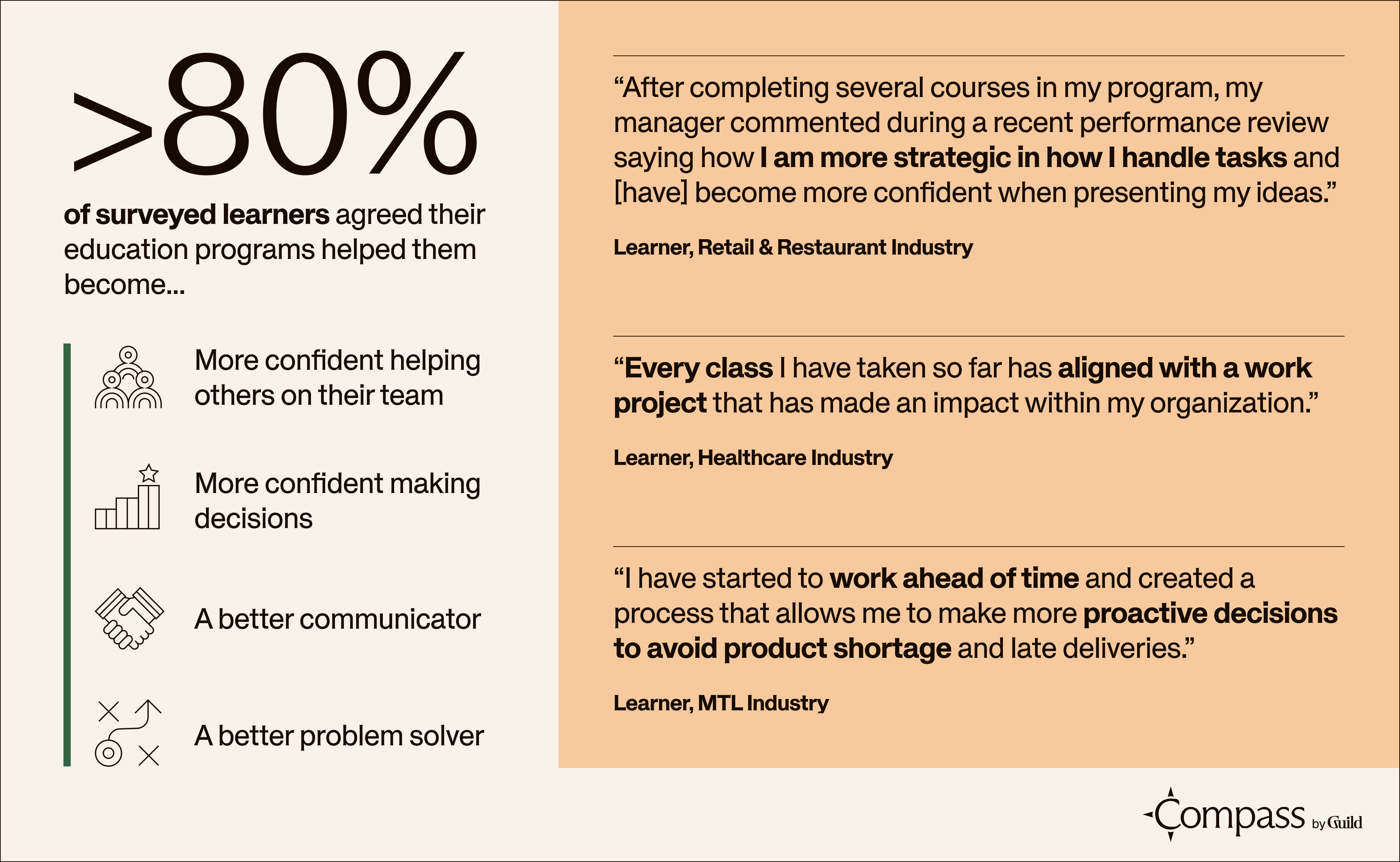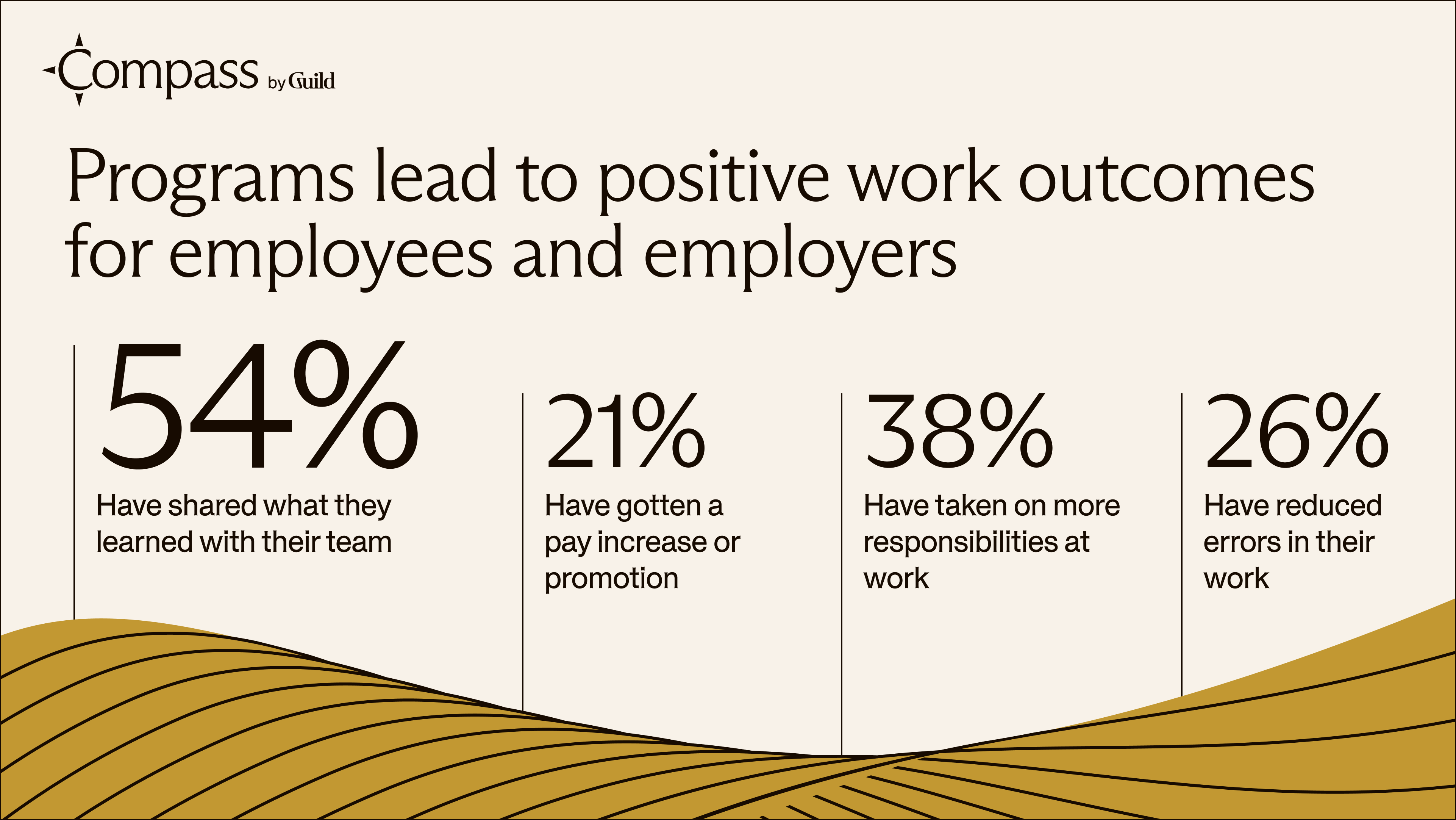Matthew Daniel |
Despite massive investments in learning and development — approaching $400 billion a year, by some estimates — critical skill gaps persist across nearly every industry and role.
The reason? It’s not a shortage of content. If anything, there’s too much content. From five minute videos to hour-long e-learning modules to in-person workshops, the learning marketplace is oversaturated with options.
Skill gaps endure because most learning isn’t designed for performance impact. Much of the learning-and-development (L&D) industry still optimizes for surface-level metrics like clicks, seat licenses, and satisfaction scores. The result is training that stops at instruction and ignores the exposure and experience needed to build practical capabilities. Employees take e-learning with no clear goals, accountability, or space to practice. Skills fade before there’s even a chance to put them to work.
But there’s some encouraging news from recent Guild data: When employees are encouraged and given support to directly apply what they learn, L&D investments pay dividends in the form of higher productivity, confidence, and team performance.

We went straight to the source. In May, we surveyed 1,000 active and recently graduated Guild learners across healthcare, retail, manufacturing, and other industries. We asked what they’re learning (and have learned) from Guild and other learning providers; how they’re using what they learned; and what’s changed for them, their teams, and their organizations as a result. The findings offer a clear window into where learning is working and where it’s not — and why.
Insight No. 1: Most employees actually want to apply what they’ve learned — right where they are.
A common concern among employers is that investing in employee education may accelerate attrition — that is, once workers gain desirable new work skills, they’ll leave. But Guild data tells a different story. In fact, the opposite appears to be true: Guild learners are significantly more likely to stay, not leave. They’re applying what they learn on the job, gaining confidence, and sharing knowledge with their teams.
Far from triggering brain drain, strategic education investments appear to deepen engagement, boost retention, and unlock business value:
When asked, 75% of Guild learners told us they want to apply new skills in their organization. Other recent Guild data supports this finding: Program graduates actually turn over 77% lower than their peers who aren’t engaging with Guild, with 76% of graduates deciding to stay with their employer at least 12 months following program completion. These findings counter the perception that “over-investing” in skills causes a risk of “brain drain” and attrition.
79% of Guild learners say they apply what they learn on the job, and two-thirds suggest their manager has noted improved performance.
Insight No. 2: Applying new skills drives immediate productivity gains.
One of the most telling findings from our study: More than seven in 10 Guild learners (71%) report feeling more productive since starting their program. Across industries, Guild’s learners reported an average productivity increase of 54%, which shows up in various ways:
80% of learners say they’ve become better at communication, decision-making, collaboration, and problem-solving.
38% have taken on more responsibility at work.
26% say they’ve reduced errors in their role.
The impact of applying what’s learned
Guild learners we interviewed told us that applying what’s learned builds momentum for them to be more productive and advance in their careers:
“I’ve started to work ahead of time and created a process that allows me to make more proactive decisions to avoid product shortage and late deliveries,” one manufacturing-industry learner told us.
“Being in the program has taught me to be more organized ... I take notes better, keep track of details better, and record information better,” added a healthcare learner.
Insight No 3: Good learning has a multiplying effect — even for non-partipants.
When learning truly cements in the minds of the learners through application, learners take what they’ve learned back to their jobs and share it with others. Our research revealed that 54% of learners in Guild programs have shared new skills with teammates. This data reinforces the belief that allowing learners to have “teach back” moments to share with others only solidifies the behavior change in learners to a greater degree.

Insight No. 4: Coaching is a key enabler.
To better understand what drives learner persistence and successful application of skills, we dug into the data — and one enabling factor stood out. There are 23 more completions for every 100 short form learners who work directly with Guild Coaching, signaling higher engagement and stronger support in fast-paced, work-aligned environments.
But the impact goes much deeper than that. Coaching helps learners set meaningful goals, process setbacks, and apply newly acquired skills to their day-to-day roles. Coaching also reinforces accountability and helps build confidence. Perhaps most critically, a coach makes learning real; they are a human, steadying force amid the vast technical complexity of today’s learning ecosystems. In many cases, they’re the reason learners keep going.
Takeaways for CHROs and L&D leaders
This moment calls for more than a bigger content catalog. As learners grow frustrated with rigid course deadlines — and as organizations continue to invest in seat licenses that prioritize volume over value — skill gaps are widening.
What’s needed is a shift from learning as content delivery to learning as capability development. That means designing for real-world application, embedding reflection and stretch assignments, and measuring success by collective growth rather than course completion. It also means investing in human support like coaching and developing clear pathways to advancement.
In the end, learning should be a shared strategy for building the kind of resilient workforce companies need now: adaptable, applied, and ready for change and uncertainty.



